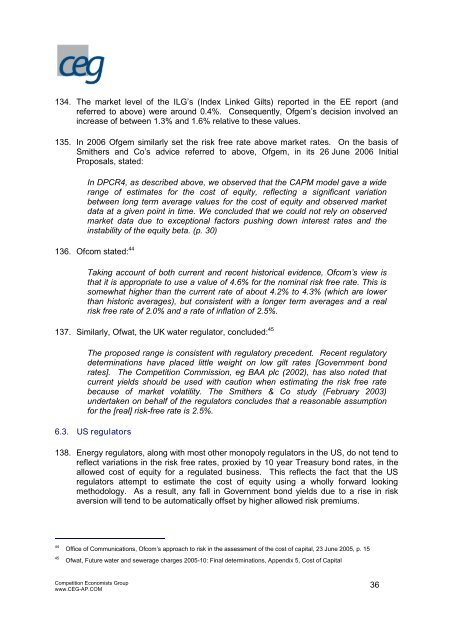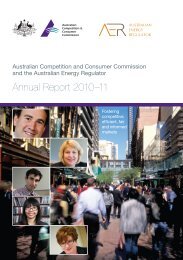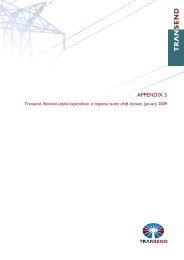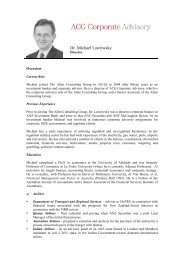Internal consistency of risk free rate and MRP in the CAPM
Internal consistency of risk free rate and MRP in the CAPM
Internal consistency of risk free rate and MRP in the CAPM
Create successful ePaper yourself
Turn your PDF publications into a flip-book with our unique Google optimized e-Paper software.
134. The market level <strong>of</strong> <strong>the</strong> ILG’s (Index L<strong>in</strong>ked Gilts) reported <strong>in</strong> <strong>the</strong> EE report (<strong>and</strong><br />
referred to above) were around 0.4%. Consequently, Ofgem’s decision <strong>in</strong>volved an<br />
<strong>in</strong>crease <strong>of</strong> between 1.3% <strong>and</strong> 1.6% relative to <strong>the</strong>se values.<br />
135. In 2006 Ofgem similarly set <strong>the</strong> <strong>risk</strong> <strong>free</strong> <strong>rate</strong> above market <strong>rate</strong>s. On <strong>the</strong> basis <strong>of</strong><br />
Smi<strong>the</strong>rs <strong>and</strong> Co’s advice referred to above, Ofgem, <strong>in</strong> its 26 June 2006 Initial<br />
Proposals, stated:<br />
In DPCR4, as described above, we observed that <strong>the</strong> <strong>CAPM</strong> model gave a wide<br />
range <strong>of</strong> estimates for <strong>the</strong> cost <strong>of</strong> equity, reflect<strong>in</strong>g a significant variation<br />
between long term average values for <strong>the</strong> cost <strong>of</strong> equity <strong>and</strong> observed market<br />
data at a given po<strong>in</strong>t <strong>in</strong> time. We concluded that we could not rely on observed<br />
market data due to exceptional factors push<strong>in</strong>g down <strong>in</strong>terest <strong>rate</strong>s <strong>and</strong> <strong>the</strong><br />
<strong>in</strong>stability <strong>of</strong> <strong>the</strong> equity beta. (p. 30)<br />
136. Ofcom stated: 44<br />
Tak<strong>in</strong>g account <strong>of</strong> both current <strong>and</strong> recent historical evidence, Ofcom’s view is<br />
that it is appropriate to use a value <strong>of</strong> 4.6% for <strong>the</strong> nom<strong>in</strong>al <strong>risk</strong> <strong>free</strong> <strong>rate</strong>. This is<br />
somewhat higher than <strong>the</strong> current <strong>rate</strong> <strong>of</strong> about 4.2% to 4.3% (which are lower<br />
than historic averages), but consistent with a longer term averages <strong>and</strong> a real<br />
<strong>risk</strong> <strong>free</strong> <strong>rate</strong> <strong>of</strong> 2.0% <strong>and</strong> a <strong>rate</strong> <strong>of</strong> <strong>in</strong>flation <strong>of</strong> 2.5%.<br />
137. Similarly, Ofwat, <strong>the</strong> UK water regulator, concluded: 45<br />
The proposed range is consistent with regulatory precedent. Recent regulatory<br />
determ<strong>in</strong>ations have placed little weight on low gilt <strong>rate</strong>s [Government bond<br />
<strong>rate</strong>s]. The Competition Commission, eg BAA plc (2002), has also noted that<br />
current yields should be used with caution when estimat<strong>in</strong>g <strong>the</strong> <strong>risk</strong> <strong>free</strong> <strong>rate</strong><br />
because <strong>of</strong> market volatility. The Smi<strong>the</strong>rs & Co study (February 2003)<br />
undertaken on behalf <strong>of</strong> <strong>the</strong> regulators concludes that a reasonable assumption<br />
for <strong>the</strong> [real] <strong>risk</strong>-<strong>free</strong> <strong>rate</strong> is 2.5%.<br />
6.3. US regulators<br />
138. Energy regulators, along with most o<strong>the</strong>r monopoly regulators <strong>in</strong> <strong>the</strong> US, do not tend to<br />
reflect variations <strong>in</strong> <strong>the</strong> <strong>risk</strong> <strong>free</strong> <strong>rate</strong>s, proxied by 10 year Treasury bond <strong>rate</strong>s, <strong>in</strong> <strong>the</strong><br />
allowed cost <strong>of</strong> equity for a regulated bus<strong>in</strong>ess. This reflects <strong>the</strong> fact that <strong>the</strong> US<br />
regulators attempt to estimate <strong>the</strong> cost <strong>of</strong> equity us<strong>in</strong>g a wholly forward look<strong>in</strong>g<br />
methodology. As a result, any fall <strong>in</strong> Government bond yields due to a rise <strong>in</strong> <strong>risk</strong><br />
aversion will tend to be automatically <strong>of</strong>fset by higher allowed <strong>risk</strong> premiums.<br />
44 Office <strong>of</strong> Communications, Ofcom’s approach to <strong>risk</strong> <strong>in</strong> <strong>the</strong> assessment <strong>of</strong> <strong>the</strong> cost <strong>of</strong> capital, 23 June 2005, p. 15<br />
45 Ofwat, Future water <strong>and</strong> sewerage charges 2005-10: F<strong>in</strong>al determ<strong>in</strong>ations, Appendix 5, Cost <strong>of</strong> Capital<br />
Competition Economists Group<br />
www.CEG-AP.COM<br />
36







